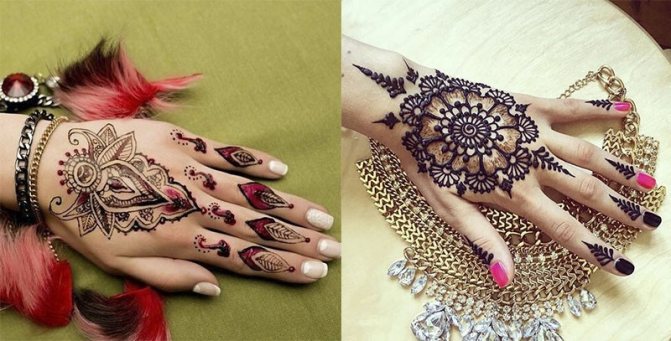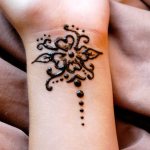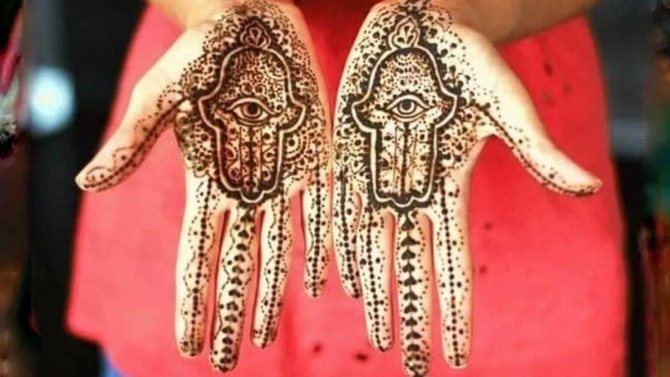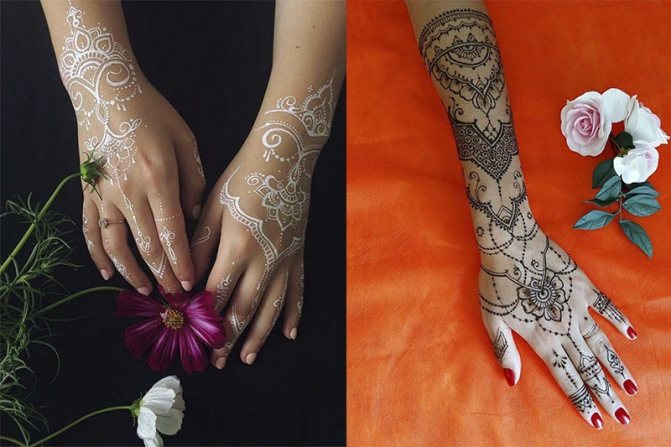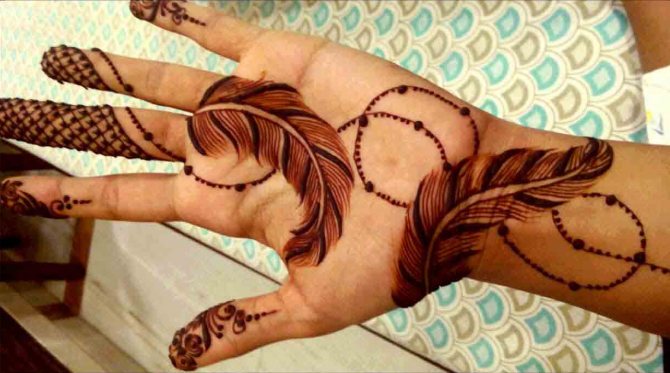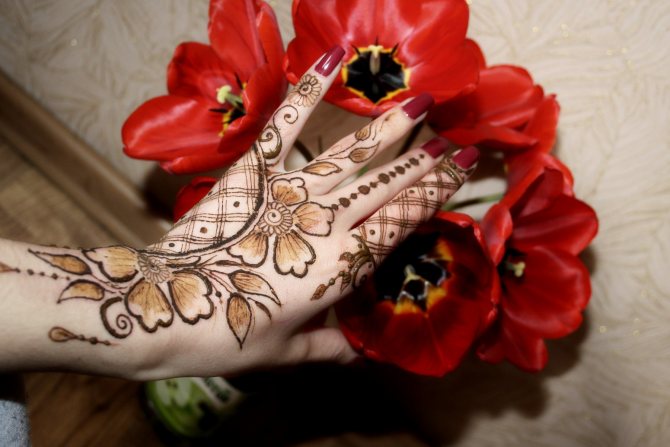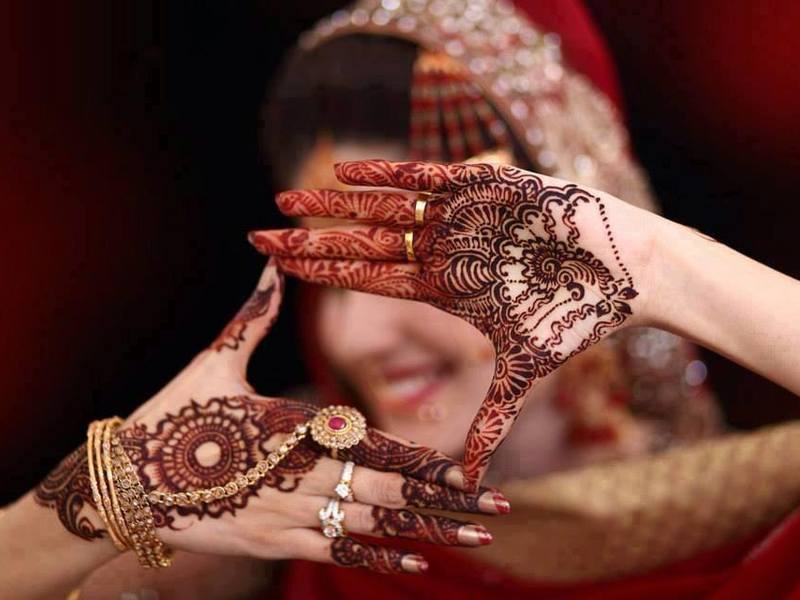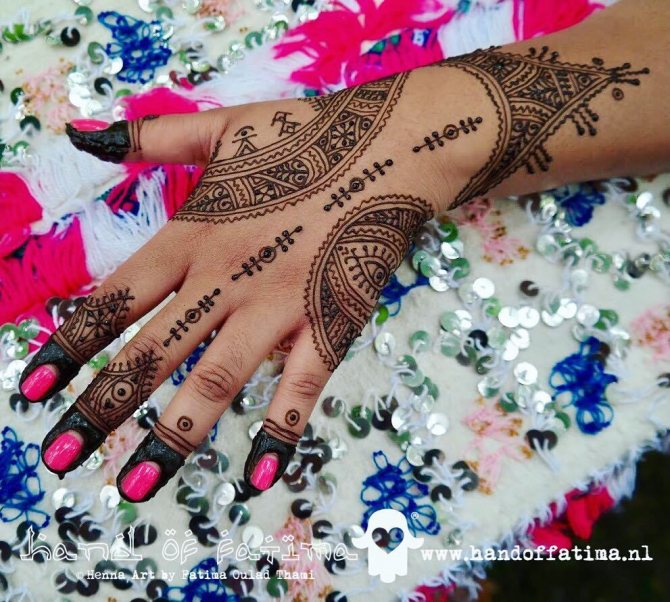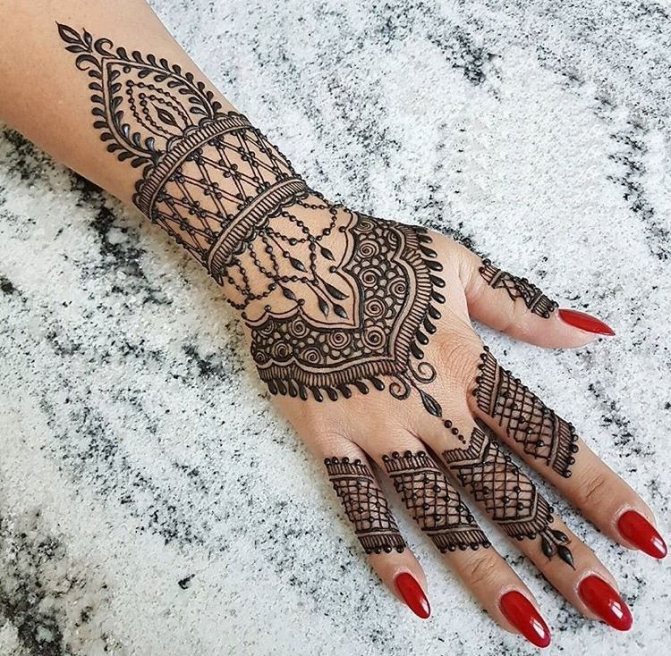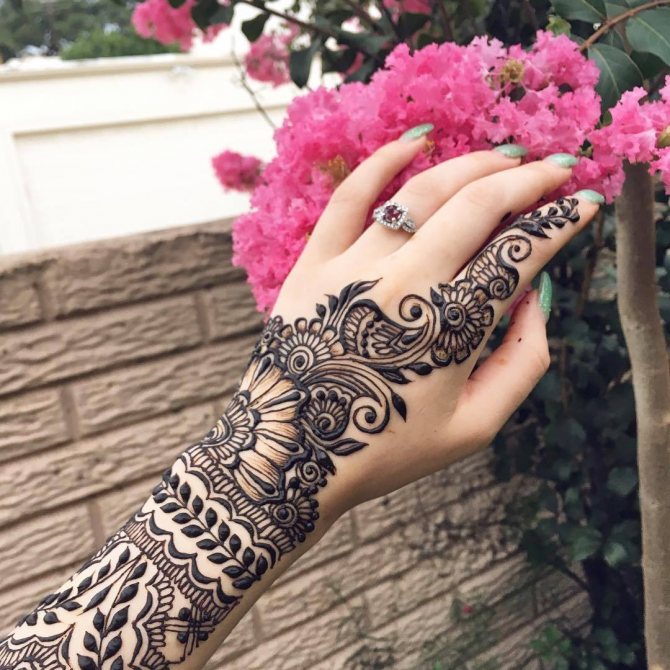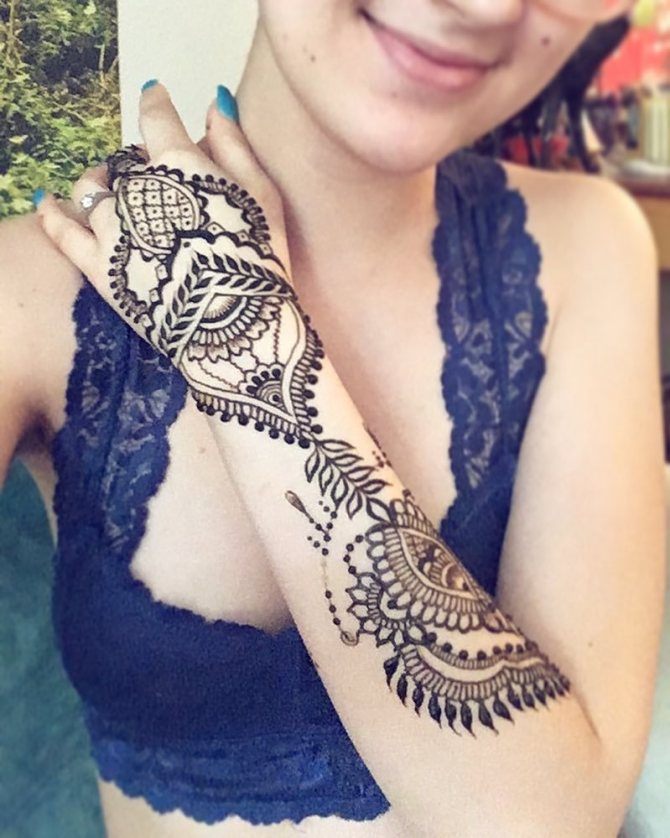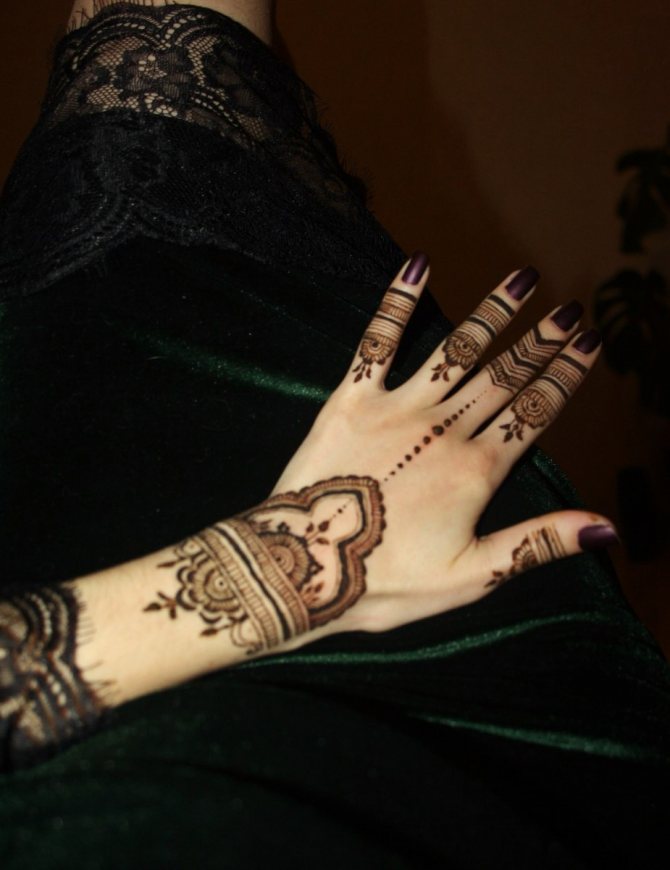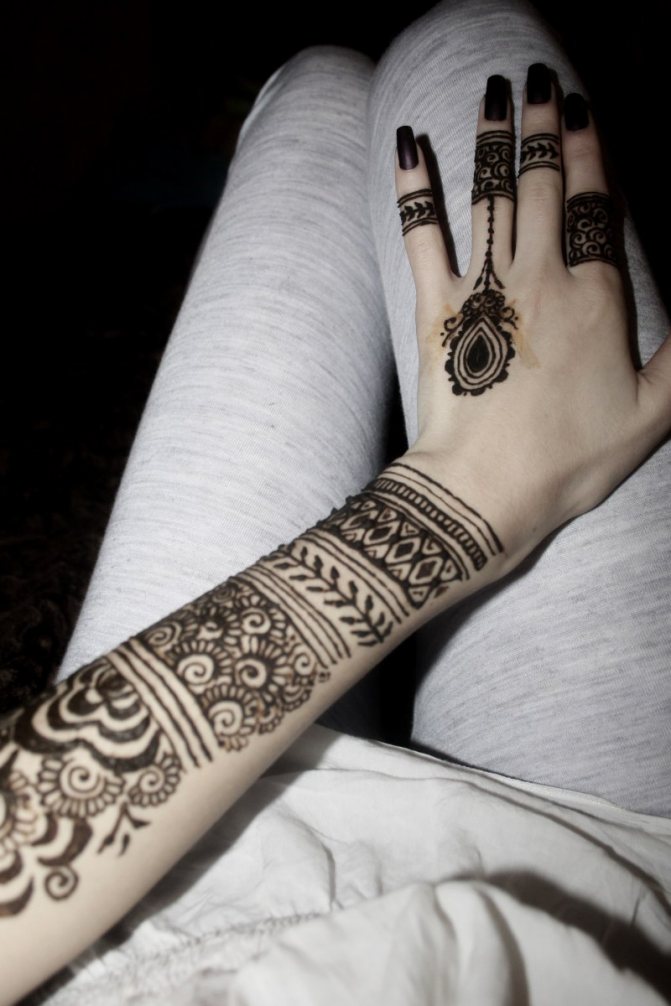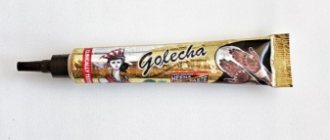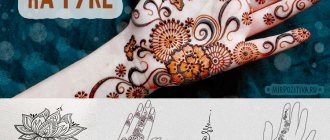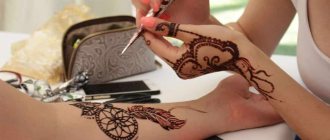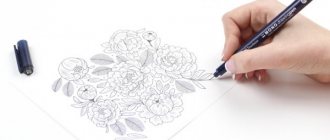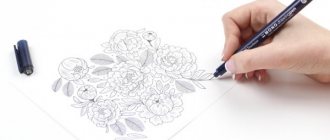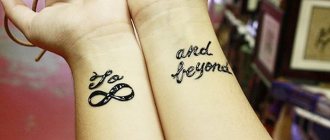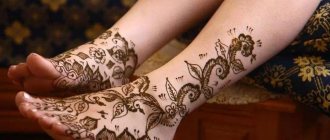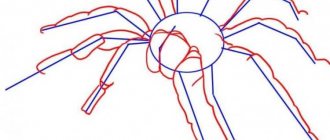On the wrist, henna drawings look sophisticated and fashionable. The tradition to paint the extremities with a firm paint came to Europe and the United States from the East. Earlier it was thought that the tradition of painting mehendi, as the henna drawings on the skin, originated in India, but scientists have recently refuted that theory. It turns out that ritual drawings with natural paint first appeared 5000 years ago in Egypt, where wealthy women decorated themselves with elegant paintings.
In India, the art of mehendi came only in the XII century. Painting on the body held brides, drawing on the legs and arms symbols of fertility and happiness. The parents of the girl buried the rest of the paint in the ground, so that the marriage would be long and happy.
It is also customary to decorate the hands and feet of young girls for marriage in Malaysia and Indonesia. And some tribes in North Africa, to decorate their bodies, simply dip their palms and feet in water with diluted henna.
Advantages and disadvantages of henna tattoos
Henna drawings on the wrist allow you to emphasize women's hands, making them more attractive. Mehendi on the skin of all the fair sex looks beautiful and original.
Temporary tattoo, as also called henna drawings on the skin, has a number of pros and cons.
The positive aspects of such decoration include:
- saturation of color;
- ease of application;
- ease of care;
- therapeutic effect;
- painless procedure;
- the ability to change the picture;
- suitable for all ages;
- a wide choice of designs.
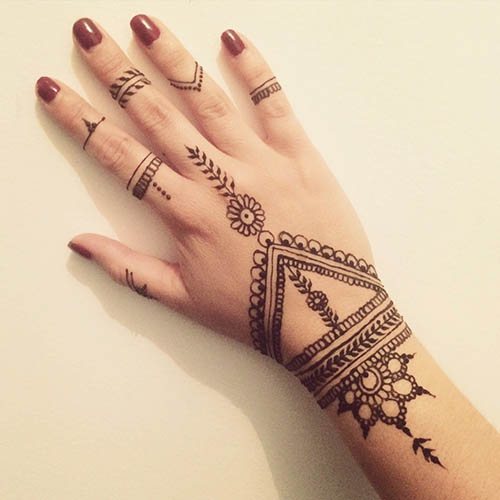
Modern henna comes in different colors, which allows you to choose the desired shade of the drawing. In addition, mehendi is not difficult to apply on the wrist and is also easy to care for the image.
The procedure of painting the body with henna, in contrast to the application of tattoos, is absolutely painless. Even a little girl can wear mehendi on the hand, because the picture will wash out with time and will not leave a trace. In addition, girls can choose the pattern they like from a large number of sketches.
The negative qualities of henna tattoos include possible allergic reactions when using black paint and fragility of the picture. Decorate the body mehendi not recommended for those who have a rash or inflammation of the skin.
How to perform mehendi on the hand step by step
To understand the technique of applying biotattoos, let's understand the process of creating a single image of mehendi on the hand step by step. There are five steps that stand out here:
- Drawing up the design of the drawing. At this stage, the master discusses with the client what and where will be drawn, what colors will be used and what subjects.
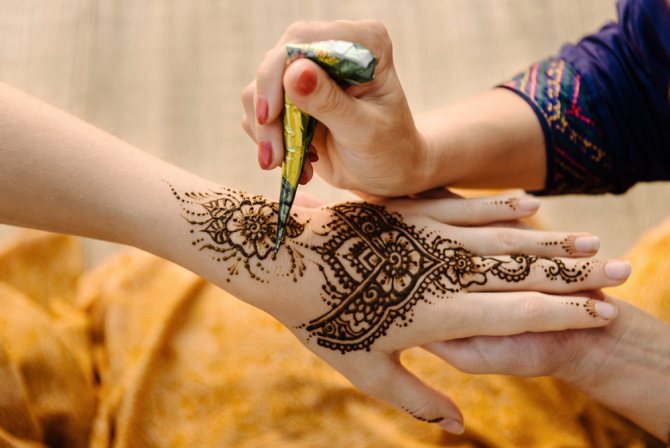

The easiest mehendi on the hands are applied on stencils, more complex patterns are made by the master individually.
- Preparation of the epidermis. At this stage, cosmetics, natural secretions, etc. are washed off the skin. Also the place of the drawing is moistened with lemon juice, so that the acidic environment makes the paint brighter.
- Drawing with a special cone. If any of the strokes are not as planned, the paint is immediately erased with a cotton pad.
- Drying of the paint. Here it is important to wait for 30-40 minutes until the henna paste forms sturdy dry crusts. They are cleaned off with a paper napkin. When applying white mehendi on the hand or multi-colored patterns, several successive dyes will be needed.
Before the coloring paste dries and crumbles, you cannot wash it off with water or soap. The dissolution of the crusts will destroy the color (at best, the pattern will be barely noticeable).
- When the paint dries completely and crumbles from the skin, wipe the drawing with oil or cream. This treatment will get rid of the tightening sensation that remains after the henna.
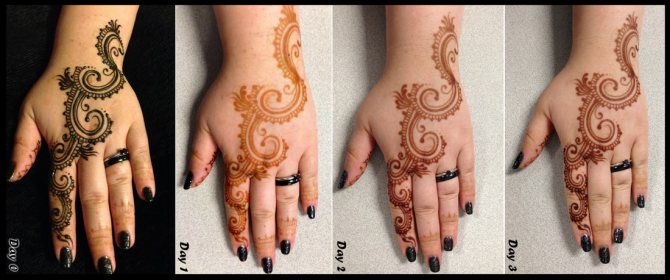

The full color of the biotattoo will take 1 to 3 days from the time of application. During this time, it is undesirable to wet it with water, so as not to shorten the "life" of the image.
What will I need for a henna design?
For henna painting, you need tools, which are ordered in specialized stores.
A beginner artist will need:
- Henna.
- Cosmetic pencils.
- Stencils.
- Cones or brushes.
- Cotton sticks.
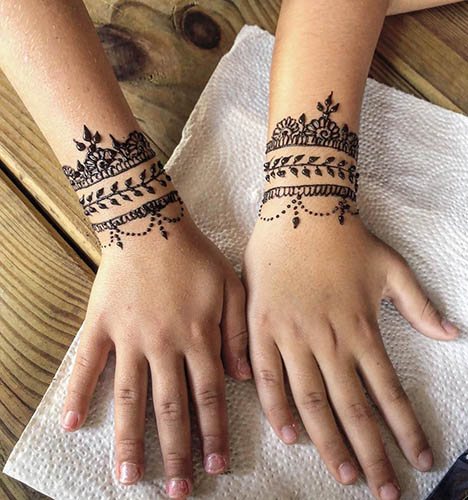

While in the past henna was found only in its natural form, in the XXI century there is the so-called "quick henna". In the first case, the powder is sold in one color - brown, and the fast paint can have different shades. Experienced mehendi creators recommend that beginners choose dye materials carefully.
In this case, it is better to opt for natural henna, as it will fully manifest itself after 100-120 minutes, so the novice master will have the opportunity and time to correct inaccuracies and wipe unnecessary elements.
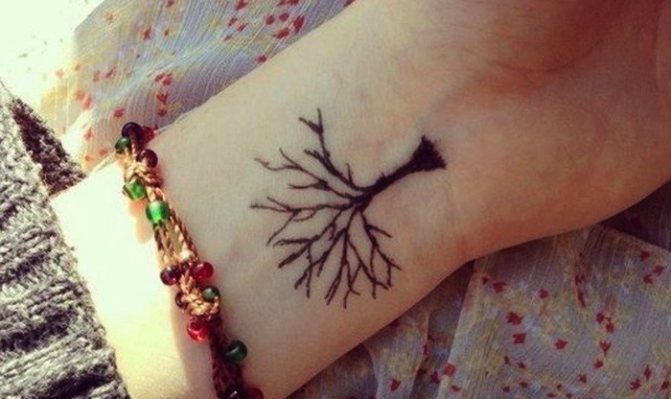

To draw the contour of the image the master needs cosmetic pencilsThese pencils can be easily drawn on the skin and easily erased. Beginners sketchers trace the drawings on stencils in order to correctly draw the desired pattern. The brightness of the work also depends on the place of application, so on the wrists and feet get the most lush patterns.
To apply henna to the skin, beginners are recommended to use special cones of paintto get a good feel for it. With experience, the creators of mehendi switch to brushes. They use cotton swabs to wipe off the excess.
Benefits of mehendi drawings
The explanation why women and men in different countries love mehendi lies in its benefits. After all, it is not for nothing that this type of art with each passing century is only becoming more popular. Before you decorate your skin with paintings, it does not hurt to learn more about what is mehendi tattoo, what are its benefits and features.
Sign up for Eyelash Extensions at Anna Klyuchko studios at a discount of 25% until November 13
12 studios across Moscow, St. Petersburg, Nizhny Novgorod and Tula
223 artists for every taste
High-quality service with a 7-day warranty
Regular promotions and gifts for customers
Full volume 1990₽ 1492₽ Double volume 2590₽ 1942₽ Triple volume 2890₽ 2167₽ Hollywood volume 3400₽ 2550₽
Book a 25% discount
Benefits:
- Has a hypoallergenic composition. Henna is a natural substance, it does not irritate the skin, there is no itching or redness either. At the end of the procedure, natural oil is applied to the dermis.
- It hides the imperfections of the skin. Girls are especially anxious to look their best at an important event. The large openwork mehendi pattern helps to hide birthmarks, acne, pigmentation or a scar.
- Comfortable conditions during the creation of the pattern. For the client, mehendi and removal of the patterns is absolutely painless. During the session, the master does not use needles or anesthetic injections. No discomfort at all. The paint can gradually come off the body on its own, without interference, just scrubbing off during the bathing procedures.
- It's easy to change your look. What is good about henna paintings is that, in comparison with the classic tattoos, the image can be changed every two weeks. The main thing is to follow the rules of mehendi care. Preparation for replacement does not require a long recovery with expensive procedures.
- Henna has a beneficial effect on the skin and the body as a whole. We have already said about the antibacterial properties of the dye. In addition, the application of the product promotes the healing of small lesions, cracks, cuts. The composition includes beneficial ingredients that nourish the skin, so henna is used to treat skin diseases, and its smell soothes headaches.
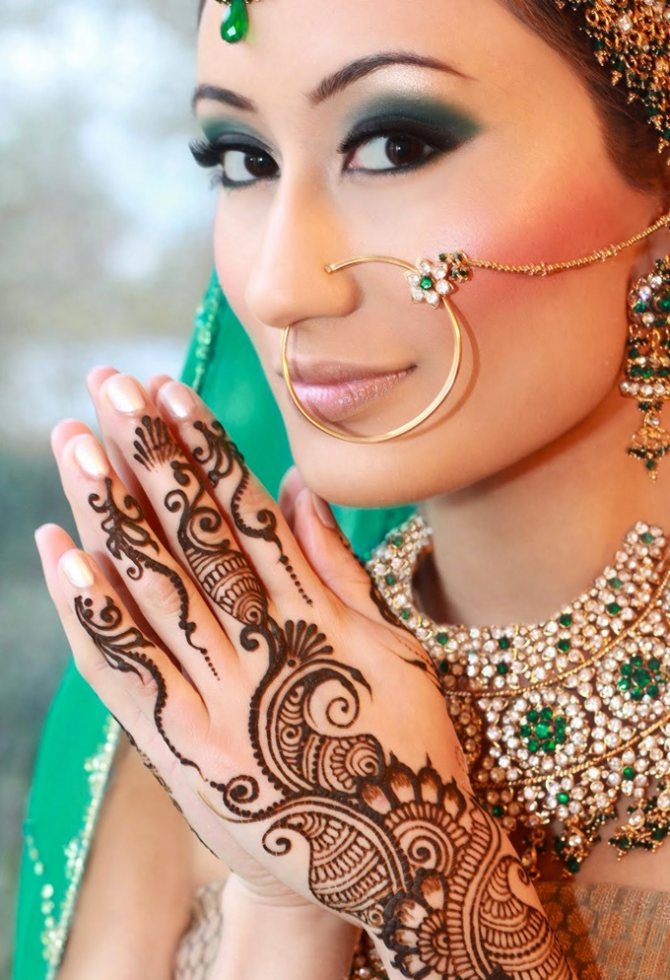

The features of mehendi skin decoration can include the following:
- Short-termism. The image is preserved three to four weeks, and then gradually erased, no matter how carefully you followed the recommendations for care.
- A small number of colors. The natural colors of henna are brown, dark brown and black. In some cases, such as wedding mehendi, the drawing can be done with white hypoallergenic acrylic paint, but this is more of a body art rather than a classic option.
- Mendi requires careful maintenance. The drawing is done with natural paint, a natural preservative is also used to fix it, so some effort must be made to ensure that this beauty lasts as long as possible.
- There is a limited choice of places on the body to create mendi. It is best to apply the images on the rougher skin areas that are in less contact with clothing, such as the ankles, back, wrists, back of the neck and shins. Myself to make a quality embellishment, perhaps, will be inconvenient, so it's worth finding a good specialist for this purpose.
What to draw with?
Drawing henna on the wrist is a painstaking and creative work. For those who want to learn the basics of mehendi on their own and do it correctly, experts recommend mixing henna paste with their own hands without help. There are several recipes for this.
For the recipe #1 you will need:
- henna;
- strong tea brew (1/2 cup);
- lemon (1/2 fruit);
- sugar (2 tbsp.).
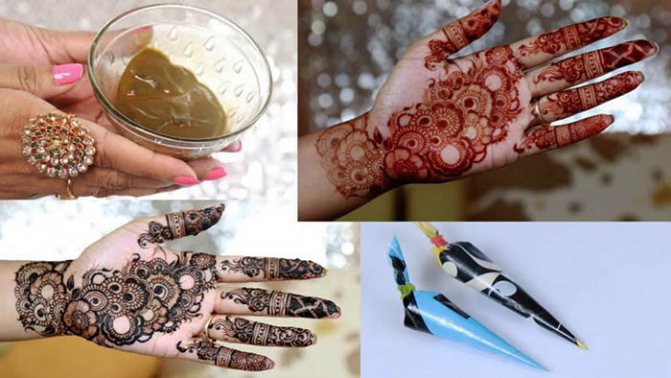

All the ingredients are poured into a cup, stirred and leave for 20 minutes to infuse the paste.
For recipe #2 you need:
- henna;
- instant coffee (4 tsp.);
- water (1 tbsp.);
- clove oil (5 drops);
- Eucalyptus oil (5 drops).
For preparation, coffee should be mixed with water and boiled until ¾ of the initial volume of liquid remains in the container. Then add henna and oils to the coffee and mix the ingredients thoroughly. Leave the paste to infuse for 120 minutes.
For the recipe #3 we need:
- hot tea/coffee (1 tbsp.);
- lemon juice (3 drops);
- henna (5 l.);
- olive oil (3 drops).
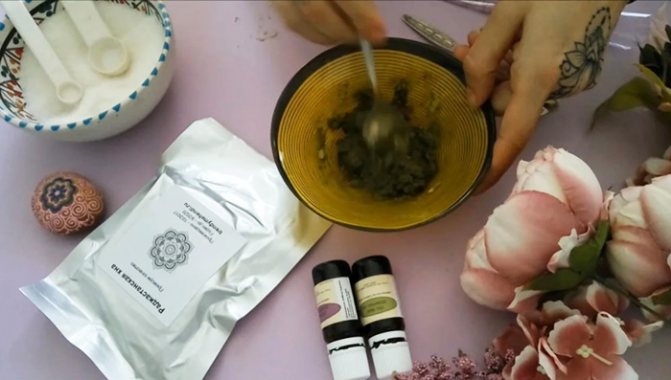

To obtain a dyeing pulp, all the ingredients are mixed and let them stand for a few minutes.
For recipe #4 you need:
- henna;
- strong tea;
- lemon (1/2 of a fruit);
- vegetable oil (1 drop).
To obtain a homogeneous mass, the ingredients are thoroughly mixed in a deep container and let them stand for 3.5-4 hours.
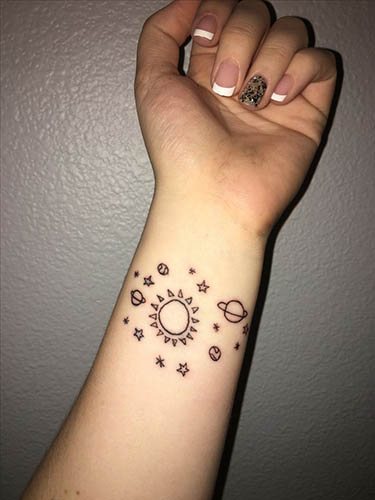

A picture applied with such mixtures will last on the skin for up to 25 days. In addition, the prepared paste can be stored in a dark place for up to 20 days.
How to draw henna?
The drawing on the wrist is applied unhurriedly, and this is the main rule of body painting mehendi.
The process of creating a natural henna image is as follows:
- the skin is prepared;
- choose a sketch;
- apply the stencil;
- heat the cone;
- fill in the empty areas in the stencil;
- let the picture dry;
- rinse off the excess with warm water;
- blot the place of the drawing;
- Lubricate with any oil.
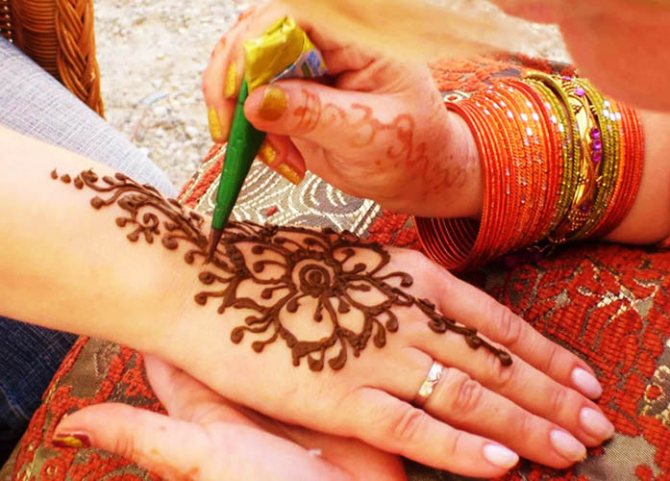

Before applying mehendi the skin area where the procedure will be carried out, should be cleaned with a scrub and well rubbed. After that, they choose a sketch and try on the drawing, applying a stencil.
Experts recommend warming up the cone in hands before drawing, so that the mixture can be well and evenly applied. Fill the empty spaces of the stencil with a thick layer of paint, not being afraid to lay out the excess.
After the pattern is formed, you need to let it dry for 40-60 minutes. The necessary time is determined by the thickness of the henna layer on the skin. Once the mixture has dried and begun to crack, it is rinsed off under a warm running stream of water or removed with a wooden spatula. After rinsing, the place of the temporary tattoo is blotted with a towel and lubricated with cosmetic oil.
The way of holding a cone or a tube of henna is different for everyone. Before starting the procedure, a small section of the cone is torn off at its sharp end and its contents are pressed with the thumb and forefinger. If the master uses a tube, but it removes the cap and put the tip of the desired width. In the process, the paint is also squeezed out with thumb and forefinger of the working hand.
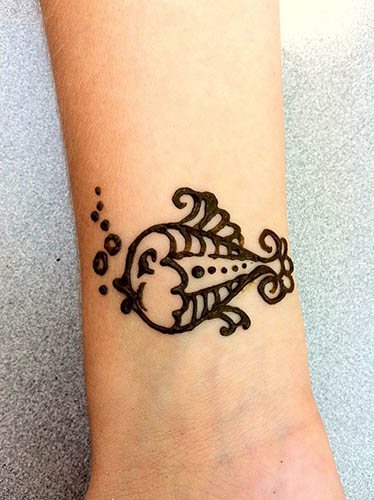

In the process of drawing, it is necessary to smear the drying drawing with a mixture of lemon juice and sugar. This method will make the mehendi more durable than usual. For those who do not know how to draw, it is recommended to start with small drawings in order to get a hand full. Stencils are suitable for those who immediately want to work qualitatively and accurately.
How to draw mehendi at home: peculiarities of the procedure of work with henna
Mastering the art of mehendi is not so difficult. Depending on your artistic skills, you can draw both ready-made (purchased) henna, and self-mixed to the consistency of sour cream. The advantage of self-made henna is the possibility to add lemon juice, black coffee or tea brew to make the drawing more vivid, saturated and resistant. The advantage of the ready-made material is the ease of work. The thin spout applies lines of the required thickness, and the unused part of the henna can be stored in the refrigerator and reused. All this is especially important for creating mendi at home by beginners or non-specialists in body art. You can apply the pattern with water-soluble paper or by hand (with wooden sticks) or use ready-made stencils with an adhesive layer, which fit tightly to the skin and allow you to apply henna in layers without flowing under the contour.
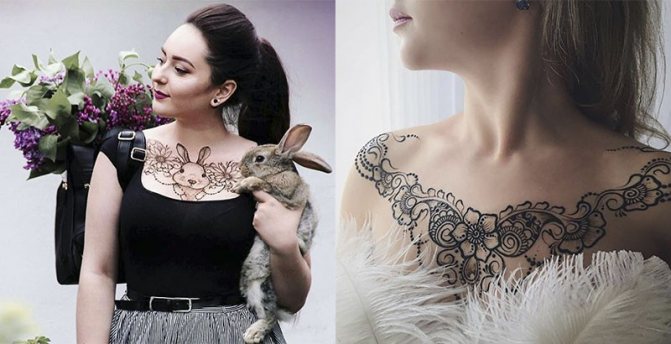

During the embodiment of the desired ornament is necessary:
- In the place where the biotattoo is applied, it is better to steam the skin beforehand for better penetration of henna into the open pores. Then the molecules of the coloring composition of the henna mixture will anchor more securely in the skin;
- Prepare in advance the surface on which you will sit. For example, spread a disposable sheet, put your hand (foot) on it, sit comfortably with your hip turned. Or use a hairdresser's peignoir (apron) to avoid accidentally dropping henna on your clothes;
- Since henna absorbs quickly, you need to stock up on cotton swabs and lemon juice to correct application imperfections. All corrections should be made within a minute, so that no traces are left on the skin;
- For even application of lines and even release of the paste, the spout of the henna cone should be held over the skin, pressing gently on the cone. If you want to get a lighter pattern, apply the paste in a thin and wide layer. For dense color and brightness of the pattern, apply the henna in two layers, letting a little grab the first layer;
- Carefully dry the ornament. The biotatu need to dry not less than 6-8 hours, so you should plan in advance the time for the quality realization of your artistic idea. Within 24 hours mehendi tattoo must not be exposed to water. And immediately after the applied layers have dried, do not wash them off, but carefully shake them off (scrape them off with a spatula) and apply a fixer oil;
- The color of the henna will appear fully in about 40 hours after drawing, and in order to avoid its accidental damage and smudge, it is worth a few hours to wrap the picture with plastic wrap.
The symbols on the wrist and their meaning
Henna drawings on the wrist have their own meaning.
Most often in this area girls wear floral ornaments or ancient solar symbols:
| Symbol . | Meaning |
| Point | The human soul, the basis of the universe. |
| Drop | Infinite energy |
| Circle | Integrity, wholeness, change in life |
| Square | Stability and honesty |
| Triangle | Serenity and Health |
| Cross | Source, starting point |
| Star | Divinity and hope |
| Star with 5 rays | Five elements on Earth |
| Star with 6 rays | Harmony between a man and a woman |
| Octagon | Sides of the World |
| Spiral | Reconnecting with Primal Energy |
In addition to geometric designs, plant elements are used in mehendi.
The most frequently depicted on the body of girls are:
- buds - love and new life;
- leaves - abundance, prosperity, wealth;
- lotus - innocence, health and eternal life;
- liana - flexibility, success in undertakings, development;
- fruit - immortality, joy and happiness;
- Indian cucumber - fertility, prosperity;
- Vine - loyalty.
Mehendi also features the sign 'om,' which many people recite during meditation. It is used to symbolize the universe and wisdom.
In mehendi, the elephant symbolizes peace, harmony and courage and the fish symbolizes freedom, prosperity and fertility. There are mandalas in mehendi that represent prosperity and the right flow of energies.
Interestingly, on the hands looks the eye of Fatima, which brings the owner protection from negative influences and indicates his chastity. If the sign of the sun is applied to the skin, it is a symbol of wisdom and infinite life energy. The moon on the wrist is a symbol of femininity and the harmonious passage of all cycles in the body.
In addition to traditional henna drawings on the body apply non-traditional for mehendi images, such as birds or hearts. The drawings on the beaches during the summer holidays are popular with the natural dye.
Ancestors believed that each symbol on the skin, has a sacred meaning and influence on a person, enhancing or weakening it in certain qualities. In today's world, the original symbolism given to body art has not survived, but their general meaning is still there.
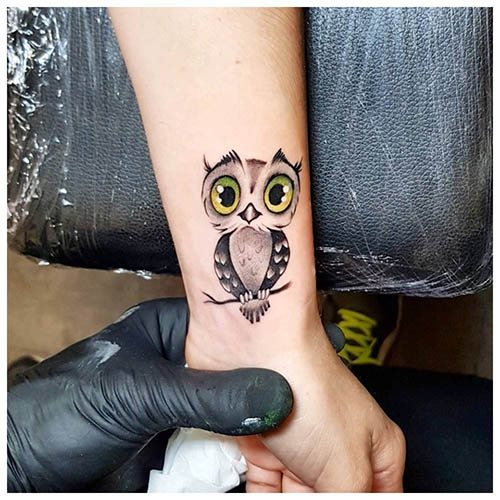

For example, the owl on the wrist is a symbol of wisdom and longevity, and the dove with a twig in its beak denotes peace and harmony. The swan on the hand symbolizes fidelity, femininity and boundless love, and the peacock is a sign of joy in life and beauty.
The cat on the skin is a sign of dexterity, wisdom, independence and longevity, while the tiger symbolizes strength and lightning-fast reactions. Black panther henna is applied by those who want to demonstrate to others their leadership qualities and the ability to protect themselves and their families.
The black panther can be painted on the hand with a dandelion, from which parachute seeds fly out. In this case, the picture indicates the lightness of character of the owner.
Chamomile henna on the body is a sign of purity of feelings and truth in relationships, and the rose is a symbol of passion and bright love. Lily on the wrist indicates purity and innocence of the girl.
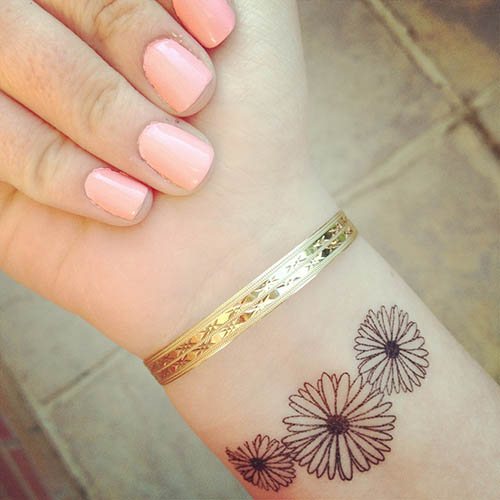

Some women are asked to henna an anchor on the wrist, which symbolizes constancy and a stable position in society. The crown on the body denotes superiority and a person's desire for power, and the dream catcher protects against bad thoughts during the night's rest.
Drawing henna on the hands and insects. A bee on the wrist symbolizes hard work and family values, and a spider symbolizes femininity and inner strength. If the insect sits in the web, it indicates the connection of all the cosmic energies in one person.
A fly on the hand is a protective symbol, it protects from evil and bad thoughts coming from ill-wishers. A butterfly drawn with henna on the wrist is considered a sign of immortality and rebirth.
What is mehendi and what is its history
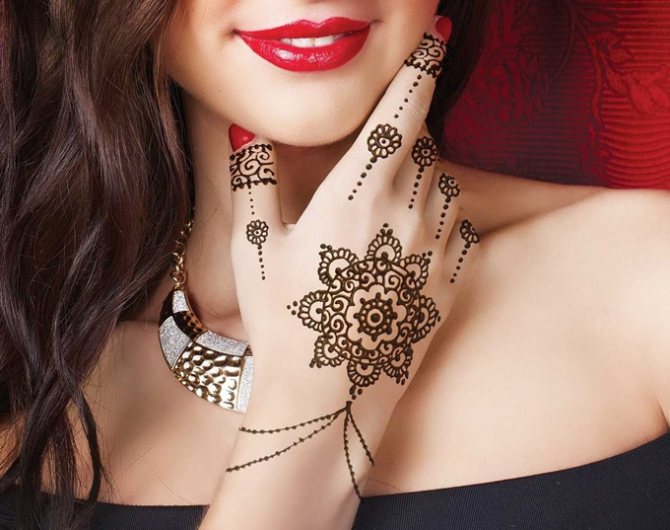

What is mehendi or mendi is known to many. It is the art of decorating your body with drawings made with natural henna, which came to us from the East. The word "mendi" translates from Hindi to "henna". Researchers have not yet been able to determine exactly in what country this trend was born. According to historians, it could have been India or ancient Egypt. Since those times have passed centuries, but the technique of applying mehendi (in other words - kamfir or kofer) has remained unchanged. If compared to the classic tattoos, which are widespread in European countries, this painting does not damage the skin and can not cause any disease.
Recommended reading:
- What not to do after eyelash extensions
- What eyelash extensions to choose for yourself
- Eyelash care: tips from professionals
There are several reasons why this cultural tradition is widespread throughout the world. Some girls see it as a way of self-expression, a chance to stand out from the crowd, a fashion trend. Others, who have studied the issue more deeply, know that with the help of fantastically expressive drawings you can protect yourself from negative influences.
Four styles of mehendi can be found today - Arabic, Asian, Indian and North African (Moroccan):
- The Moroccan style is characterized by many geometrically strict lines and floral motifs. Henna is a natural antiseptic, so in hot countries you can find women with fully painted feet and palms.
- Arab masters of mendi use a floral theme. Usually the body is decorated with patterns and plots based on small flowers.
- Indian traditional paintings present a variety of symbols and images, in which the masters put a certain meaning, as they are usually performed for participation in some ritual or festival. In the drawings you can see animals, intertwined geometric figures and floral motifs. Often the feet and hands are completely covered with paintings, and then they look like socks or gloves.
- The Asian style resembles the Indian style. The difference is that henna is also applied on the tips and pads of the fingers, as well as on the sides of the hands and feet.
The version of the origin of mehendi in Ancient Egypt is the most popular. There are many facts that among the rich and noble ladies, it was customary to decorate different parts of their bodies with henna patterns. Men subsequently enjoyed this tradition as well. It is also known that mummies of Egyptian rulers were also decorated with sacred patterns to protect them on their journey to the afterlife.
After a while, the lower classes of Egyptian society began to paint their bodies with mehendi patterns, because it was easy to buy henna. Later on, this technique was applied in the Middle East, North Africa and Asian countries.
In Central Asia and India, the usual natural henna is used more often, so the drawings are obtained brown or reddish hues. Morocco and other North African countries use henna with the addition of charcoal or ash - the patterns on the skin turn out darker and even black. In many countries where mehendi is popular, during pregnancy women draw patterns on the ankles and abdomen to protect the foetus from evil eyes.
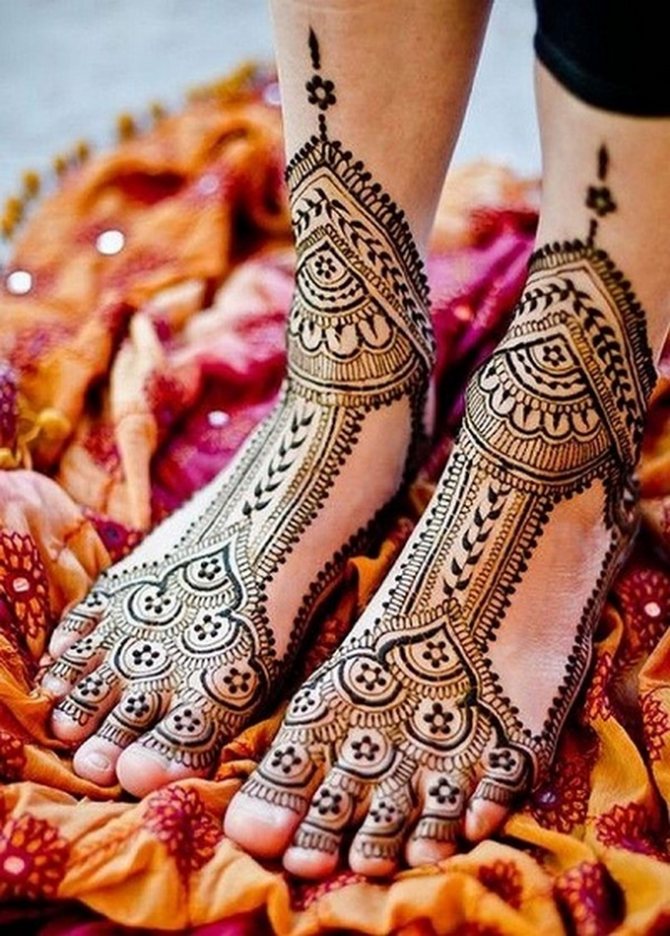

According to the traditions of Islam, only brides and married women were allowed to decorate themselves with such paintings. Muslims were forbidden to have tattoos on their bodies because after the procedure, the body was no longer as Allah had intended it to be. This was especially true for women. They could only display the exquisite beauty of mehendi to their husbands. Gloves and socks hid the patterns on the hands and feet, which were considered too intimate adornments and were only meant to heighten the passion in the marital bedroom.
Indian women love mehendi. In this country, three-year-old girls already decorate their hands and feet with bright patterns. More often girls walk around with drawings made with henna, but you can also meet men with painted on the body.
For girls who were going to be brides, drawing on the skin mehendi acquired a special meaning. Symbolic images on the arms, shoulders, legs and feet, made by experienced older female relatives, were supposed to initiate the future wife into the intimate knowledge necessary in the matrimonial relationship. This ritual could last five hours or longer, sometimes even taking two nights, as they tried to make as dense, exquisite and colorful a painting as possible. If henna remained, it was to be buried in the ground so that the husband would never cheat on his wife.
Inscriptions
Henna drawings on the wrist may contain an inscription in a foreign language. In this case, the symbolism of such mehendi must be found out from the meaning of the words.
The most popular inscriptions in English on the wrist of girls are:
- "Love is life" - "Love is life";
- "I will love you forever."
- "I am lovely."
- "Together forever."
- "Husband is my everything."
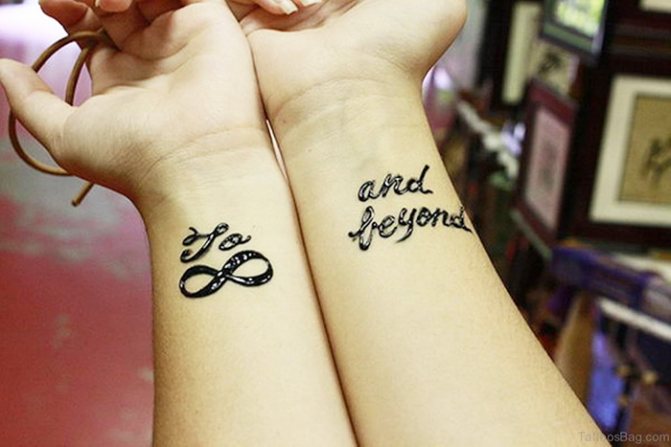

Girls like to henna also funny inscriptions or names of loved ones. Those who like German better can put their favorite expressions in it.
Among the popular ones look good on the hands:
- "Enttäusche mich nicht" - "Do not disappoint me;
- "Vergeben, verliebte sich, fuhr fort" - "Forgiven, unloved, moved on";
- "Nur vorwärts" - "Only forward";
- "Das Leben ist ein Märchen" - "Life is a fairy tale";
- "Glücklich, modisch zu sein" - "Happy to be fashionable".
Some write on their hands verses from their favorite songs or the names of their idols. Girls also often put words and phrases in Arabic on their wrists. In addition, popular are the henna images of hieroglyphs or Arabic numbers.
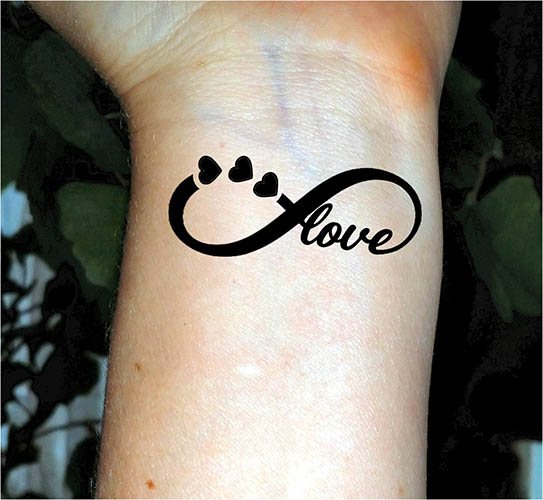

Sometimes flowers are woven into the letters, or a cardiogram line can come out of the name of a loved one. Words can be in the form of notes or located among the stars and planets. There are phrases written on ribbons or bows.
In addition to traditional letters are printed on the wrists in henna and runic symbols, which are considered the letters of the Celtic and Slavic alphabets.
Most often on the skin can be found:
- Jera - helps in the realization of the intended;
- Ken - physical health, healing, protection;
- Lagu - develops vitality and intuition;
- Man - helps in business and develops intelligence;
- Thorn - brings good luck, protects against evil, promotes changes in life;
- Ur - the beginning of a white streak of good luck.
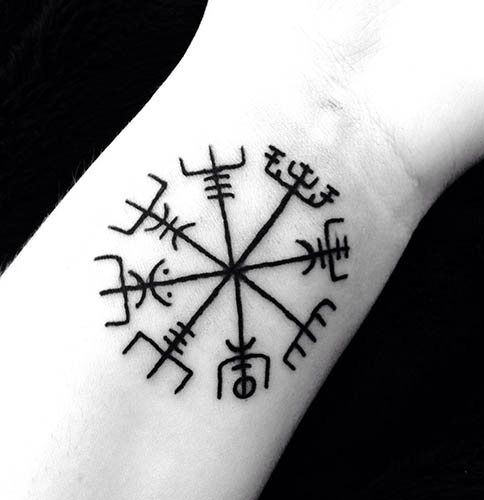

Some girls put on their skin staves of runic symbols. One of the popular is the "Helmet of Terror". The ligature helps to protect against negative energy and removes ill-wishers from life.
Runes on the body for a long time is not recommended, so they are not suitable for permanent tattoos. These ancient symbols are well drawn in henna. So they have time to give people the necessary qualities and they are easy to neutralize by washing off the body.
Tips for beginners
Those who are just starting to draw henna on the body, you need to know some secrets that will help keep the drawing and paint longer.
Beginners should remember that:
- First, you need to get a hand on the draft. This will make the strokes more confident and accurate.
- To keep the picture on the body longer, it is moistened in the process with sweet lemon juice.
- The color of the temporary tattoo depends on the heat. While the mehendi is drying, it is kept in the sun, under a UV lamp or over a fire.
- Some experts recommend removing the dried henna with a wooden stick.
- After the procedure of removing the paint, the drawing is smeared with any oil. This also saturates the color.
- Fresh mehendi, without excess paint, you can wrap the food film and hold it for a while. The procedure will allow the picture to last longer.
- It is better to store the paint cones or tubes closed in the refrigerator.
- A drawing made with natural henna lasts for several weeks, and a fast one - up to 7 days.
- It is not recommended to apply a drawing to the same place many times. This is due to the fact that there may be irritation to other cosmetics.
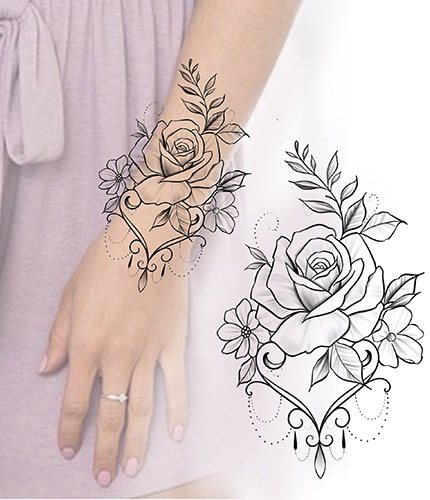

In addition to the secrets of drawing and storing the colors, you also need to know how to prolong the "life" of mehendi.
To do this, it is recommended:
- Do not wash the place of application for several hours after the procedure.
- Do not use a washcloth while showering or bathing.
- Limit the contact with water of the treated area.
- Oil the area before each bath.
- For a while, forget about peeling.
- Temporarily refrain from going to the pool or steaming in the bath.
- Minimize friction of mehendi on clothing.
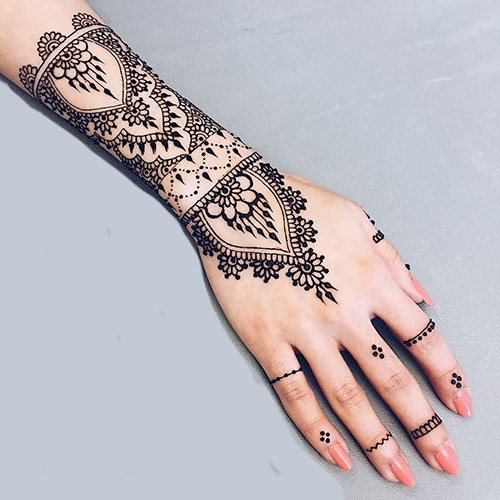

Henna paintings on the wrist look very impressive
Henna drawings look good on any wrist. The picture visually lengthens the fingers and makes them more elegant. With mehendi a girl can decorate her body and express herself. Temporary tattoo more practical than permanent, because you can wash it off and not to worry that it will spoil the skin or bore over time.
Wedding mehendi: how to elegantly complement the image of the bride?
Classic chocolate or ochre henna patterns look appropriate on all other occasions, except the main holiday in the life of the girl. The so-called white wedding mehendi, emphasizing the fragile beauty of the bride, has become a popular and spectacular way to complement the wedding dress. It wonderfully harmonizes with the bouquet and veil, becomes an extension of the wedding dress itself, looks very feminine, delicate and elegant. Temporary wedding body art can be both in visible parts of the skin, and become a kind of surprise for the future spouse (if it is located on the parts of the body closed by the dress).
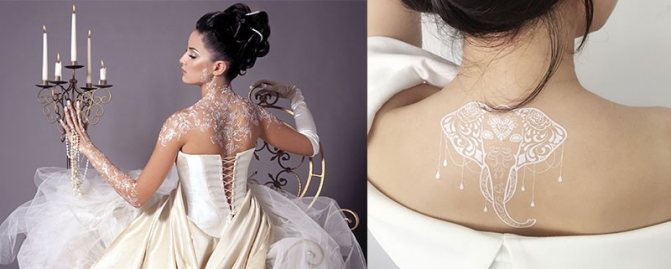

White henna mehendi is also safe for the skin, as well as natural henna patterns, but differs significantly less persistent - from 1 to 3 days. The reason for this fragility is that natural white henna does not exist, and a special hypoallergenic acrylic paint is used to create the pattern. A hypoallergenic glue is added to its composition, which guarantees the durability of the ornament, but does not cause discomfort to the bride. White henna does not penetrate the skin like its natural counterpart, so the care of wedding mehendi is much easier. White mendi for the bride will not rub off or smudge if it is applied to clean, non-greasy skin and secured with regular hairspray on top.
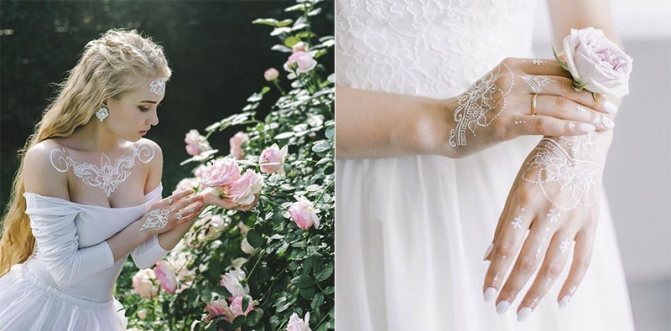

Such a way to decorate the body of a beauty suggests a lot of stylish and original variants of embodiment. This can be openwork "gloves" to the elbow or to the wrist, or patterns of lace, complementing the dress with open shoulders (imitation of capes or straps). No less original and fabulous look jewelry on the face. These can be floral patterns descending from the eyelids or barely noticeable twigs on the cheeks, flowing into an ornament on the neck. Very spectacular and romantic look also imitations of stockings or garters, or even the exact image of a wedding bouquet.
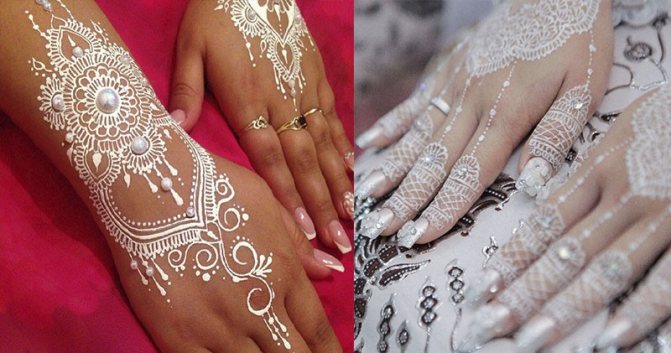

Beautifully made mehendi can easily become the main decoration of the bride, replacing the luxurious jewelry. It will look delightful on the photo and will give the young woman a lot of positive emotions both during the application, during the celebration, and at the end of the most magical evening of her life.
A stylish and unusual accessory or a kind of good luck charm (black or white, chocolate or copper) - once applied to the body mehendi will catch you by its mesmerizing beauty and will definitely inspire you to repeat it. Don't be afraid to trust your body with henna, experiment on your own or enlist the help of a master. Remember, this oriental fairy tale will bring you only positive emotions!
